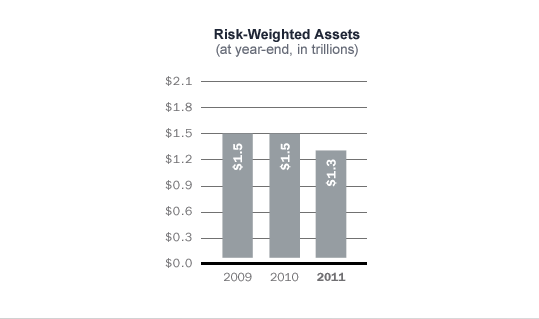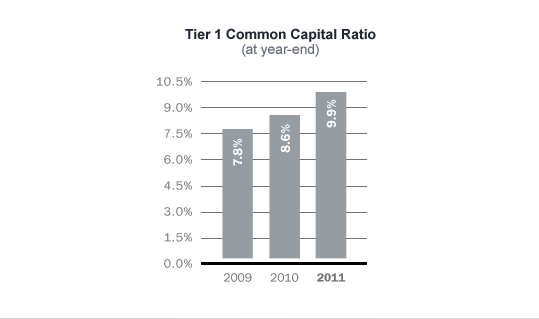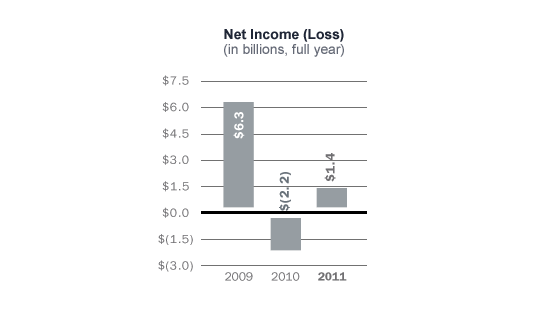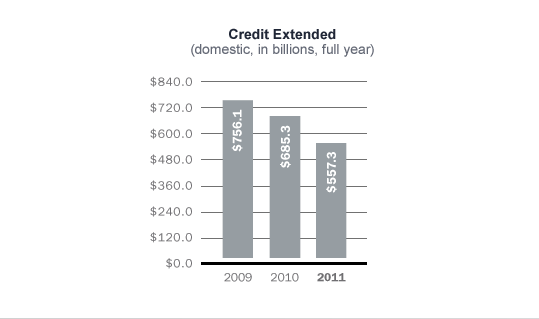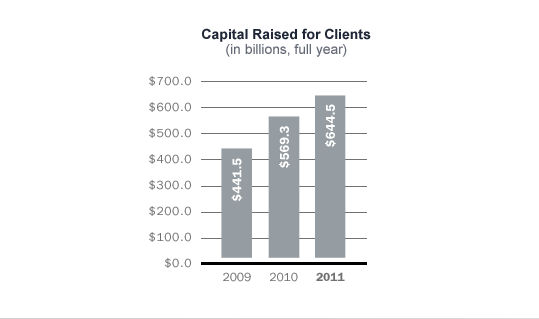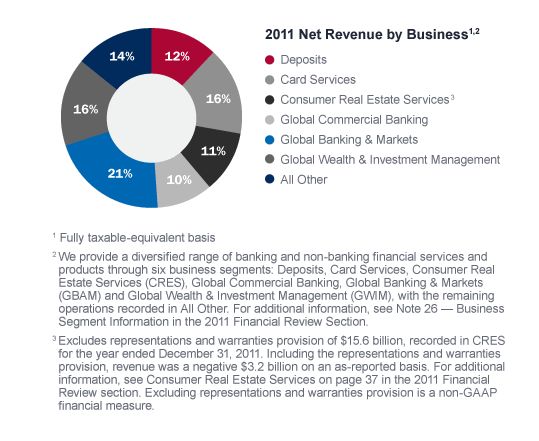Letter to Shareholders
"What does 'customer-focused' mean, and what are you doing to make it real?"
"We listen to our customers and clients, learn what their needs are, and do all we can to provide the advice, services and products that respond to those needs. To do that best, we want to have the broadest possible financial relationship with our customers and clients. Simply put: We can do more for them than anyone else, wherever they are in their financial lives."
To our shareholders,
In 2011, in the face of significant challenges, we made great strides in transforming our company. We streamlined our businesses, built capital and liquidity and, most important, maintained or built on market-leading capabilities to serve our customers' and clients' core financial services needs. Our company has reduced risk and is less complex. As a stronger, more straightforward company, we are building deeper relationships with our customers and clients, and are doing what we can to help restore confidence and strength to our economy.
In 2010, we established a clear goal — to be the finest financial services firm in the world in the eyes of our customers, our employees and each of you as shareholders. There is ample evidence that we are making progress on the course we set. Our focus and strategy are clear: We deliver to three groups of customers and clients the leading capabilities they need to manage their financial lives and businesses. Simply put: We can do more for people, companies and institutional investors than any other financial services company. And day after day, we are proving it in the marketplace.
Our financial results for 2011 show both the progress we have made and the challenges that remain. For the full year, the company reported net income of $1.4 billion, or $0.01 per diluted share, compared with a net loss of $2.2 billion, or $0.37 per diluted share, in 2010. Revenue, net of interest expense, on an FTE basisFootnote *, declined 15 percent to $94.4 billion, reflecting, among other things, increased reserves for mortgage-related matters.
Obviously, our stock price does not yet reflect the work we are doing to strengthen capital, reduce risk and attract more business from our customers. There are many issues weighing not only on us, but on the entire financial services industry. These include concerns about the global economy; a sustained period of near-record low interest rates; the implementation of new regulations and capital requirements; how these new rules may affect our ability to deliver for our customers and clients; and the time it will take to resolve mortgage issues.
There is more work to do, but today we are better organized to serve our customers and clients; to offer customers more reasons to do more business with us; to earn the profits our shareholders expect; and to contribute to economic growth in all of the communities we serve.
"What is the financial strength of the company today?"
"Since the financial crisis of a few years ago, we have increased our capital to record levels and increased our Tier 1 common capital ratio to twice what it was before the crisis. The same goes for our liquidity; at the end of 2011, we had $378 billion in Global Excess Liquidity Sources, and our time-to-required funding, which measures the amount of time that our parent company could fulfill its obligations without tapping external funding sources, increased to 29 months."
A Strong Company Begins With a Strong Balance Sheet
In 2011, Bank of America made significant progress to streamline its balance sheet by selling non-core assets, building capital and reducing debt. At the end of 2011, the company's Tier 1 common capital ratio was 9.86 percent, up 126 basis points from the previous year, long-term debt was down $76 billion to $372 billion and Global Excess Liquidity Sources were up $42 billion to $378 billion.
Continue to build a fortress balance sheet
When we set out to transform our company two years ago, our first urgent challenge was to strengthen our foundation — the balance sheet. We focused on selling non-core assets, increasing capital ratios, building liquidity and reducing risk.
Let me highlight a few examples of our progress.
On December 31, 2011, our Tier 1 common capital ratio was 9.86 percent, up 126 basis points from the end of 2010, and double the level in 2007 as we headed into the economic crisis.
During 2011, we increased our Global Excess Liquidity Sources by $42 billion to $378 billion, and we improved our "time-to-required funding," which measures the length of time that our parent company could pay all unsecured contractual obligations without tapping external sources of funds, to 29 months from 24 months.
We also reduced our risk in 2011 by decreasing risk-weighted assets by $171 billion to $1.28 trillion, including reducing legacy risk exposures in our Global Banking & Markets business by 35 percent to $15 billion.
The result is a stronger, leaner company better prepared to handle economic uncertainty.
The second urgent challenge we addressed was resolving issues related to the mortgage crisis.
In January 2011, we announced agreements with Fannie Mae and Freddie Mac to resolve representations and warranties repurchase claims involving certain residential mortgage loans sold to them by entities related to Countrywide. In April, we announced an agreement with Assured Guaranty Ltd. to resolve all of the monoline insurer's outstanding and potential repurchase claims involving 29 first- and second-lien residential mortgage-backed securitization (RMBS) trusts where Assured Guaranty provided financial guarantee insurance. In June, we announced an agreement to resolve nearly all of our Countrywide-issued first-lien RMBS repurchase exposure with respect to 530 trusts with an original principal balance of $424 billion. And, in March 2012, we joined with the four other largest U.S. mortgage servicers in reaching global settlements to resolve federal and state investigations into certain origination, servicing and foreclosure practices.
The progress we've made on these issues covers a significant portion of our exposure to issues related to the mortgage crisis and housing downturn. And while we still have more work to do on these exposures and other mortgage-related matters, we ended 2011 with almost $16 billion in reserves to handle the costs of mortgage-related representations and warranties claims. Resolving these and other claims will take time, but we are moving through these issues aggressively and resolving them in the best interest of our shareholders — settling when appropriate, and contesting them when we believe that is the right course. There is considerable disclosure on our mortgage exposure in the Financial Review section of this report, and I encourage all shareholders to review this section.
Having made so much progress on the two urgent challenges of balance sheet strength and mortgage issues, our company is now better positioned to deliver on all our operating principles as we move forward in 2012.
"How do customers feel about the basics: Is Bank of America providing high-quality and efficient service to customers?"
"Customers and clients consistently tell us they appreciate the one-on-one service they get in our 5,700 retail banking centers and from their financial advisors and commercial, corporate and investment bankers. Our investor clients consistently rank the research they get from our research platform at or near the best in the world. Customers also appreciate the many ways they can reach us, including ATMs, mobile applications and online. In areas where the service is less consistently satisfactory, we are investing and improving. Often this is the result of disparate technology platforms, service centers that have not yet been consolidated and rationalized after mergers, or, in the case of home loans modifications and other challenges, the sheer spike in volume following the mortgage crisis. These are the areas we are focusing on in 2012 to bring service quality across the organization up to the highest level."
Supporting Customers and Clients
Bank of America continued to support the economic recovery in 2011 by extending $557 billion in credit to U.S. consumers, small and medium-sized businesses and large corporate clients, and raising approximately $644 billion in capital on behalf of its global clients.
The credit we extended and the capital we raised helped our customers and clients meet their goals, such as buying a new home, paying for college, adding another assembly line or expanding into new markets.
Being customer-focused
Being customer-focused, in the broadest sense, simply means being responsive to the needs of customers and clients — providing the products and services they want, when, how and where they want them.
To do this more effectively, we conducted an important reorganization of our company in 2011 when we named two executives to newly created roles as co-chief operating officers. The intent of this reorganization was to better align our operating units to serve our three groups of customers. David Darnell, a 33-year veteran of the company who has led many of our businesses during his tenure, is responsible for those businesses that serve retail customers, wealthy clients and small businesses in the U.S. Tom Montag, who has led global wholesale financial businesses for more than 25 years, is responsible for all of our businesses that serve medium-sized to large companies and institutional investors worldwide.
Retail customers put a premium on convenience, clarity, choice and value. Over the past two years, we have overhauled the design of our products and services to emphasize these attributes. Our customers have responded: Average deposit balances across our retail businesses grew by $20 billion in 2011 to nearly $663 billion, and we continued to see growth in consumer spending in our credit and debit card businesses.
We also continued to help distressed mortgage customers, either by modifying loans to create sustainable, long-term solutions, or by helping them through a dignified transition to new housing. We have now modified more than 1 million mortgage loans since the beginning of 2008, and Bank of America is now responsible for about one in three mortgage modifications in the country. This work is helping individual borrowers and supporting the recovery of the housing markets and the broader U.S. economy.
We originated $6.4 billion in small business loans and commitments in 2011, and we hired more than 500 new small business bankers during the year to further support small business customers. We expect to reach our goal this year of adding 1,000 small business bankers to serve these customers and help our economy keep growing.
We provided our affluent clients with a full set of investment management, brokerage, banking, retirement, wealth structuring and trust services through our Merrill Lynch Global Wealth Management, U.S. Trust and Merrill Edge businesses. In 2011, we continued to invest in these businesses to ensure we meet our clients' needs, with the addition of more than 1,600 wealth advisors to our team. Our long-term flows of assets under management from these clients grew to $28 billion.
Large companies and institutional investors need the best global corporate, investment banking and research capabilities integrated to help them achieve their business goals — and we are delivering. We maintained our No. 2 global ranking in investment banking fees by working together to deliver the full capabilities of the company to our clients. We also continued to be a source of leading research and ideas for our institutional investor clients, as Institutional Investor magazine named Bank of America Merrill Lynch "Top Global Research Firm of 2011."
Being the best place to work
We believe that by being the best place to work for our employees, they can better serve our customers and clients, which, in turn, will result in good returns for our shareholders. To put this philosophy into practice, we continue to improve training and career opportunities. In 2011, we placed tens of thousands of teammates in new jobs throughout the company, representing opportunities for employees to build new skills and benefit from new experiences.
Every employee has had opportunities to share ideas for how we can be a better place to work through Project New BAC, our companywide program designed to align our resources as efficiently as we can to better serve our customers and clients. These changes are not only making Bank of America more efficient, they also are making it easier for employees to do business and operate across the company. And, we have continued to earn recognition as an employer of choice from national and international publications, including Working Mother, Military Times EDGE, Black Enterprise and Latina Style.
Our employees also continue to donate their time to their communities. We believe strongly in the importance of employee engagement in our communities, and we encourage employees to take up to two hours per week of company time for volunteer activities. Collectively, our employees logged 1.5 million volunteer hours (including company time and personal time) in 2011 and gave to many important causes through $25 million in individual donations as well as through the United Way campaign, which raised $34 million for community needs.
"What is Bank of America doing to help get the housing market going again?"
"We have modified more mortgage loans than any other servicer: More than 1 million homeowners have been helped. We are making one in three modifications in the entire country. Helping our customers who are at risk of foreclosure with sustainable mortgage payments through loan modification is good for our customers, our investors and the overall U.S. economy."
Helping Homeowners
Providing solutions for distressed homeowners remains a critical focus for us. Since January 2008, we have completed more than 1 million loan modifications under our own programs and government programs. In partnership with national and local nonprofits, we have also conducted outreach programs to work with homeowners who are in danger of falling behind on their payments. In addition, we recently announced innovative partnerships in Cleveland, Chicago and Detroit to assist with the demolition of deteriorating structures and to donate low-value vacant and abandoned properties for redevelopment, open space, urban farming or other uses that benefit the community.
Manage risk well
Risk management is an integral part of our business operations. Our goal is to set a tone and create a risk management culture in which every employee is empowered to raise an issue or express a concern. That means having a well-defined, clear-cut business model, a strategy that puts that model into practice, and operating principles to guide the thousands of daily decisions that are made by managers across the company.
We have taken a number of steps to strengthen and sustain a strong risk management culture. We have developed a clear understanding of our risk appetite across all businesses. This includes seven major categories: credit risk, market risk, operational risk, compliance risk, liquidity risk, strategic risk and reputational risk. We are putting specific emphasis on improving operational risk awareness and execution throughout the company this year. Finally, we are clear about accountability — all employees understand their obligation to speak up if they have a concern, and it is part of our culture to encourage it.
Manage efficiency well
To be the finest financial services company in the world also means we must be the best operator — a company that is efficient and effective, gets it right for customers and clients and, if an error occurs, corrects it promptly and courteously every time.
At the heart of our pursuit of operational excellence is Project New BAC. We completed Phase 1 evaluations in September 2011, covering our consumer businesses and the related staff functions that support them, approving more than 2,000 ideas employees submitted to improve the way we work for customers. Many of these ideas are being implemented now. Through this work, we have a goal to reduce our expenses by $5 billion, or about 18 percent of the expenses in these areas, by the end of 2013.
Phase 2 evaluations, covering Global Wealth & Investment Management, Global Commercial Banking, Global Banking & Markets and the staff functions not subject to evaluation in Phase 1, are in progress. Evaluations will conclude this April.
Deliver on our shareholder return model
Ultimately, we will be judged by our ability to generate profits and by our stock price, which, as I've said, clearly does not yet reflect much of the work we are doing or the progress we have made. One important measure of our progress is tangible book valueFootnote **, which, at $12.95 per share at the end of 2011, held steady over the course of the year even as we significantly added to our reserves for mortgage-related exposures.
Looking ahead
While our results in 2011 were lower than we would expect in a more normal environment, we are making progress in rebuilding profitability in all our core businesses. With the economy slowly but steadily improving, we believe this trend should continue in 2012.
This year will bring its own mix of successes and challenges, but our direction is clear. We will continue to focus intently on what we can control: providing our customers and clients with the best service and most comprehensive financial services solutions in the market; managing our costs; and doing our part to keep the economy moving forward. Our long-term value will come through when we do that.
As we proceed, I would like to thank our employees for their continuing commitment to this important work; our customers and clients for their confidence in our ability to deliver for them; and our shareholders for continuing to share our journey.
As always, I welcome your thoughts and feedback as we move forward together.

Brian T. Moynihan
Chief Executive Officer
March 12, 2012

